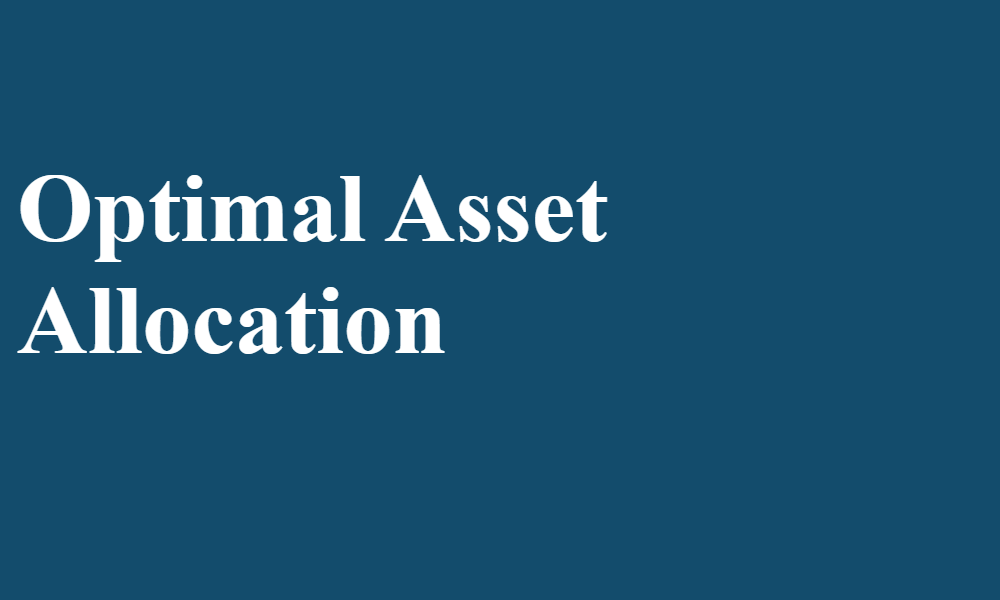Optimal Asset Allocation

A general Overview of Optimal Asset Allocation
Asset allocation is an approach of spreading investment across different asset classes instead of investing on one, its a strategy to balance risk and potential return over a given time period. This involves a mix of stocks, bonds and cash, or money market securities. Asset allocations can be altered during an investment period to ensure that a portfolio adopts to change in financial needs and goals.
The asset classes can further be divided into smaller subgroups
Large-cap stock, medium-cap stock, small-cap stock, international securities, emerging markets, fixed-income securities, money markets, real estates investments trusts.
Maximizing return, minimizing risk.
The goal of asset allocation is to help investors achieve the level of returns expected while minimizing risks. To meet this, investors need to understand the risk-return characteristics of various assets.
From the above we can infer that government bonds have the lowest risk this is because they are backed by the government but they also have the lowest returns. Equities have the highest risk but they also have the highest potential returns. This is the risk-return trade-off. High-risk choices are better suited to investors who have higher risk tolerance.
Diversification through asset allocation is important because every investment comes with its own risk and market fluctuations. Asset allocation is meant to insulate a portfolio from the up and downs of investing in a single class off securities. Even though a part of portfolio may contain volatile securities due to their potential of high returns the other part of the portfolio should contain more stable assets.
Investment decision
Every asset class has its own risk- return level, when deciding an optimal portfolio that would serve an investor, they should consider investment objectives, risk tolerance, time period for the investment and available money to invest. Asset allocation can be a tedious task, to make the process easier for investors, most investment companies have come up with model portfolios each comprised of different proportions of asset classes depending on investors risk tolerance. These portfolios range from conservative to most aggressive.
Portfolio models composition
Starting from conservative which relates with low risk to aggressive which relates to high risk we can come up the following portfolios.
Conservative, moderately conservative, moderately aggressive, aggressive and very aggressive.
Let’s delve deeper on what this portfolios contains.
Conservative Portfolio
The goal of a conservative portfolio is to protect the initial investment value of the portfolio.
This model is often referred to as capital preservation. It allocates a large percentage of the total investment to lower-risk securities such as money markets and fixed income.
A conservative investor might want to avoid stocks completely however exposure to stocks can help cushion the investor from inflation therefore inclusion of a portion of high-quality blue-chip companies is advised.
Moderately conservative portfolio
This works for an investor who wishes to preserve most their portfolios principal value but they are willing to take some risk for inflation protection. In a strategy like this, investors choose securities that pay high level of coupon or dividends payment.
Moderately aggressive portfolio
This type of portfolio is often referred to as a balanced portfolio. The balance is between income and growth. This portfolio has a higher level of risk than conservative portfolios.
In this portfolio assets composition is divided equally (almost equally) between equities and fixed-income securities. This strategy is best for investors with a longer time period and medium level of risk tolerance.
Aggressive portfolio
This type of portfolio is referred to as capital growth. Here an investor’s main goal is to achieve long-term growth of capital.
An aggressive portfolio mainly consists of equities. However, it is important to have diversification, investor with this kind of portfolio adds some fixed-income securities.
Very aggressive portfolio
With this portfolio the goal of an investor is a strong capital growth over a long period of time.
This portfolio consists almost entirely of stocks. Because it has a higher risk level the return of this portfolio will vary widely in short term.
Maintaining a portfolio
After making an investment, it is important to conduct a periodic review. Depending on whether their needs have changed or their risk aversion investors can modify portfolio’s weights.
Conclusion
The strategies above are a loose guide on how to build portfolios. Adjustments can be made to suit investors need. Investors are advised to do deeper research of the market before allocating weights to their portfolio.
